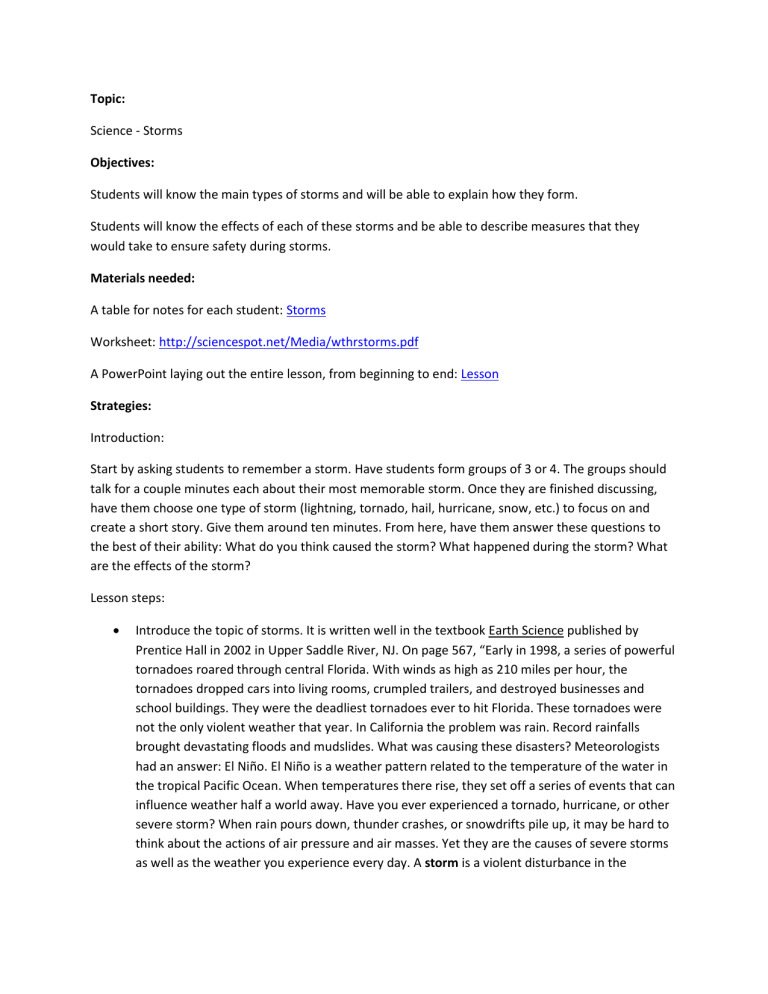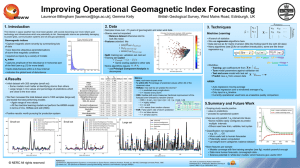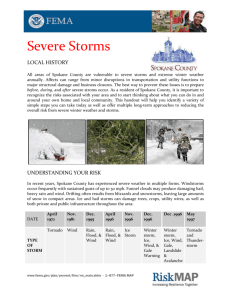Storms - Dordt College Homepages

Topic:
Science - Storms
Objectives:
Students will know the main types of storms and will be able to explain how they form.
Students will know the effects of each of these storms and be able to describe measures that they would take to ensure safety during storms.
Materials needed:
A table for notes for each student: Storms
Worksheet: http://sciencespot.net/Media/wthrstorms.pdf
A PowerPoint laying out the entire lesson, from beginning to end: Lesson
Strategies:
Introduction:
Start by asking students to remember a storm. Have students form groups of 3 or 4. The groups should talk for a couple minutes each about their most memorable storm. Once they are finished discussing, have them choose one type of storm (lightning, tornado, hail, hurricane, snow, etc.) to focus on and create a short story. Give them around ten minutes. From here, have them answer these questions to the best of their ability: What do you think caused the storm? What happened during the storm? What are the effects of the storm?
Lesson steps:
Introduce the topic of storms. It is written well in the textbook Earth Science published by
Prentice Hall in 2002 in Upper Saddle River, NJ. On page 567, “Early in 1998, a series of powerful tornadoes roared through central Florida. With winds as high as 210 miles per hour, the tornadoes dropped cars into living rooms, crumpled trailers, and destroyed businesses and school buildings. They were the deadliest tornadoes ever to hit Florida. These tornadoes were not the only violent weather that year. In California the problem was rain. Record rainfalls brought devastating floods and mudslides. What was causing these disasters? Meteorologists had an answer: El Niño. El Niño is a weather pattern related to the temperature of the water in the tropical Pacific Ocean. When temperatures there rise, they set off a series of events that can influence weather half a world away. Have you ever experienced a tornado, hurricane, or other severe storm? When rain pours down, thunder crashes, or snowdrifts pile up, it may be hard to think about the actions of air pressure and air masses. Yet they are the causes of severe storms as well as the weather you experience every day. A storm is a violent disturbance in the
atmosphere. Storms involve sudden changes in air pressure, which in turn cause rapid air movements.” o This introduction reminds students of what they have learned about air masses and gives them a little history on storms and El Niño.
Then hand students the table of types of storms (link is in the materials needed). Have them fill this out to the best of their knowledge. After a couple minutes, have them talk with a partner to see similarities and differences of what they know. At this point, they may use their books.
If time, use these websites to enhance learning and show students the application to everyday life. They can continue to fill in their sheets as they look at these websites. o http://www.cbs6albany.com/sections/weather/weatheralerts/ and http://www.cbs6albany.com/sections/weather/advisories/winter/
These two websites can be used to show the class to see an actual weather advisory for thunderstorm, tornado, and winter storms. o Here is another website to use to show which parts of the US have certain types of storms: http://www.weather.gov/ o http://www.education.noaa.gov/Weather_and_Atmosphere/Hurricanes.html
This is a great website to let the students explore for a while. Hurricanes are a type of weather pattern that we never experience in the Midwest. Allow students time to dig into what would interest them about hurricanes.
Then as a class, compile a list to fill out the tables. A table with multiple sample answers is included along with the PowerPoint. Answer table / PowerPoint (The PowerPoint is an optional lesson outline. It has all of the same information in PowerPoint form.)
Closure:
Have students get together in their project groups. Each group should decide what type of severe weather their region would have. Together, they would need to create a safety plan which includes a description, advisories, and necessary actions. Students should use correct terminology and good solid descriptions of the storm itself and the precautions people should be taking. A sample safety plan is found at http://www.spc.noaa.gov/faq/tornado/safety.html
. Students’ safety plan should include prevention before the storm, signs of the storm, what to do, and after the storm.
Assignment:
Part of the assignment includes the group project of creating a safety plan.
If completed and time, students also need to write a one-page paper about something they learned on the hurricane website, or about their story at the beginning of the class period and how their answers would change to those 3 questions after this lesson.
Finally, if necessary to evaluate, have students complete the worksheet.
Rubric:
Category
Description of the storm
Safety Plan
Level 1: Minimal
Competency
A brief description of the storm without any terminology.
Shows no learning of the lesson.
A brief safety plan with minimal steps.
Level 2: Basic
Competency
A brief description of the storm with some terminology.
Shows some learning of the lesson.
A safety plan that has almost all necessary steps.
Level 3: Advanced
Competency
A satisfactory description of the storm with good use of terminology.
Shows understanding of the lesson.
A well-thought out safety plan with all necessary steps.
Level 4:
Outstanding
Competency
An in-depth description with excellent use of terminology.
Shows complete understanding of the lesson.
A well-thought out safety plan that is easy to understand and could be easily put into action.
Evaluation:
Evaluation will be completed through the descriptions of the storm and safety plan to demonstrate knowledge of ensuring safety during a storm. Students can also be evaluated through the completion of the worksheet. Throughout the class period, evaluation of knowing the main types of storms will be done through observation, participation, discussion, and completion of the table worksheet.




